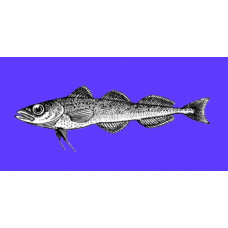Latin name
Boreogadus saida
Other name
Arctic cod, gadus saida, merlangus polaris, boreogadus polaris, pollachius polaris, gadus fabricii, gadus agilis reinhardt.
Identification
The body of the polar cod tapers significantly towards the tail. The head is large, the mandible slightly protrudes forward, and the antennae on the chin are small. The eyes are large with a diameter greater than the height of the tail stalk. The scales are small and ingrown but not overlapping. Vertebrae: 49-57. It can tolerate low temperatures due to a natural antifreeze in its blood, called AFGP glycoprotein, which prevents freezing.
Features of fish fins
Dorsal spines (total): 0; Dorsal soft rays (total): 42 - 57; Anal spines: 0; Anal soft rays: 33 - 44
These fish have a deep notch in their caudal fin.
Fish colouring
The top of the polar cod's head and the back are grayish-brown, while the sides and belly are silver-gray.
Distribution
This fish is distributed throughout the Arctic Ocean on a circumpolar basis. It extends farther north than any other species, reaching up to 85° N latitude. North Atlantic: It is found in the White Sea, Iceland, and southern Greenland, as well as up to the Miramichi River in New Brunswick, Canada. In the North Pacific Ocean, it is found in the Bering Sea, the Pribylov Islands, and Bristol Bay.
Habitat
They are marine and brackish demersal oceanodromous species. They inhabit depths ranging from 0 to 1383 meters, typically between 0 and 400 meters. They are found both near and far from shores, usually under floating ice and in headlands. They have been found in brackish lagoons and river mouths. It lives in surface sea waters freshened by thawing ice at near-0°C or sub-zero temperatures.
Size
These fish usually grow to a maximum length of 25 cm, though they can reach up to 40 cm. Their maximum life expectancy is seven years.
Behavior
In the fall, polar cod gather in large flocks and often approach the shores, forming mass aggregations in coastal waters and river mouths. Their movements from coast to coast are associated with spawning and ice movement.
Food and feeding habits
This species feeds on phytoplankton, zooplankton, and crustaceans, particularly krill, as well as juvenile fish.
Reproduction
This is an egg-laying, sexually dimorphic fish. They spawn from October to March and their eggs are floating and pelagic. Fecundity is 6,000 to 70,000 eggs. They become sexually mature at 3-4 years of age and reach a length of 19-20 cm.
Fishing
This species has only been fished in the White Sea and the southeastern part of the Barents Sea in recent years. It is caught using deep-water trawls.
Relationship with a person
Harmless. This fish does not have a strong flavor. It is used for fishmeal and oil production.
| Classification | |
| Phylum | Chordata |
| Class | Actinopterygii |
| Squad | Gadiformes |
| Family | Gadidae |
| Genus | Boreogadus |
| Species | B. saida |
| Features | |
| Conservation status | Not Evaluated |
| Habitat | Pelagic |
| Life span, years | 7 |
| Maximum body weight, kg | No information |
| Maximum length, cm | 40 |
| Sailing speed, m/s | No information |
| Threat to people | Edible |
| Way of eating | Planktonophage |
Polar cod
Tags: polar cod

